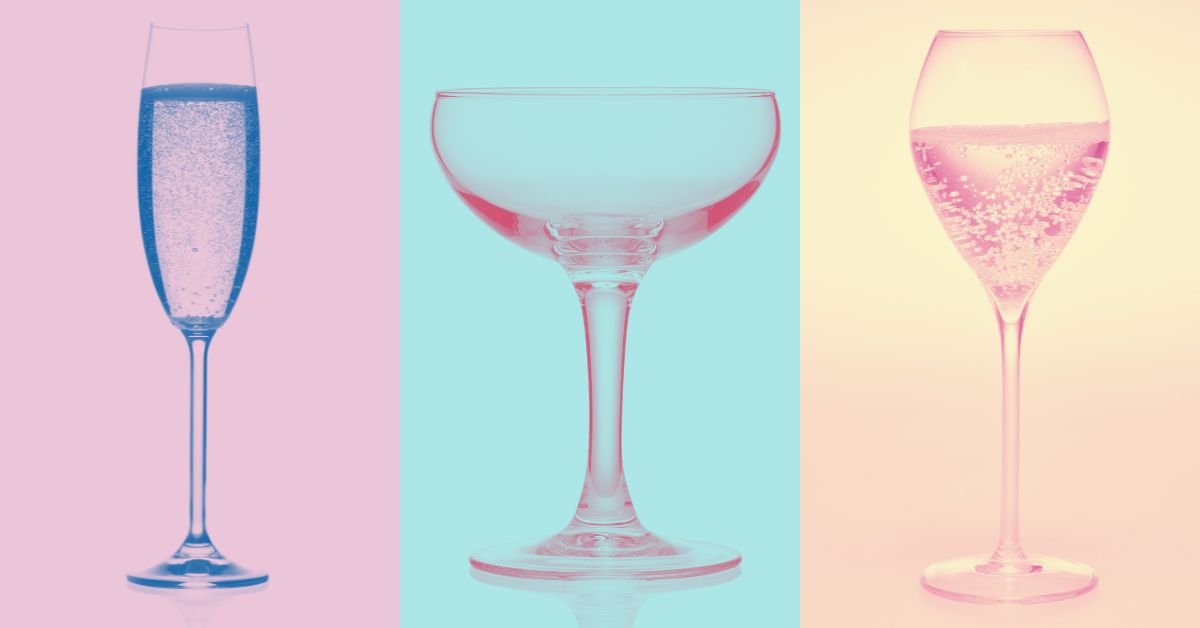You see him from across the room— tall, dark, and handsome. He flashes a quick smile, your heart flutters with anticipation, you know he is headed your way. He makes a quick stop at the bartender, the gleam of a Champagne bottle flashes (classy choice, you love it). You look away, acting coy as he heads toward you. He sets a glass of Champagne in front of you- a coupe glass of Champagne– and you think to yourself…
What the f— am I supposed to do with that?!
Okay. I have had my fun, but seriously- Champagne stemware has been a pain-point for many wine lovers. But who can argue that a Champagne flute isn’t one of the world’s most fabulous accessories? It makes sense that we have opted for stylish stemware for our sparklers— something as magical as Champagne can’t simply go in a red solo cup. But is the magic of Champagne dulled by the vessels we have made for them? We will be discussing all that and more in our basic guide to sparkling wine stemware.
Coupe Glass
Round, shallow, and legend has it, modeled after Marie Antionette’s breast. The coupe glass may be one of the most impractical facets to Champagne tradition. The Champagne coupe was popularized in the 18th century and remained in vogue until the 1930s in France, and all the way up into the 1970s in the U.S.
The coupe is a visual staple of American prohibition. (Think Leo diCaprio smoldering and raising a glass to the beholder of the 2013 Great Gatsby movie poster/ Dita Von Tease resting in a giant coupe/ Glimmering Champagne towers.) Coupe glasses are on a comeback in the craft cocktail space, but they are hardly used for Champagne these days– because they are terrible vessels for sparkling wine.
Stylish? Certainly. But the wide and shallow shape will cause your bubbles to quickly dissipate. On top of that, there’s no space to swirl, smell, and savor your bubbly’s aromas. Today, the coupe rightfully belongs to the craft cocktail bartender, not the somm.
Champagne Flute
When you think of Champagne stemware, you’re probably thinking of a flute. They’re tall, thin, and do a great job of displaying your sparkler’s mousse and bubbles. The Champagne flute was developed in the 18th century, but did not begin popping up in the scene (particularly here in the US) until the early 1950s.
The tall walls and narrow mouth allow for a steady, glamorous stream of bubbles, but because of the small surface area, the wine has less room to move around, open up, and express its aromatics.
If you have a fabulous bottle of bubbly you’ve been waiting to pop, think twice before dumping it into a flute!
Tulip Glass
Now this glass is our holy-grail for Champagne sipping. Tulip glasses are widest in the middle, with the base and stem tapering inward to form the shape of (you guessed it) a tulip bud. The tulip glass is tall enough to retain your bubbles, enough surface area to swirl, and a wide enough mouth to take them all in. At Last Bubbles HQ, we use the RIEDEL Veloce Champagne Wine Glass. You might recognise these from our Fizz Meter videos!
Some tulip glasses more closely resemble a Champagne flute, and others a standard white wine glass– we prefer the latter. You want just the right amount of surface area to savor your bubbly, and a wider basin will help you do just that.
If you don’t have any tulip glasses on hand, a white wine glass or Bordeaux glass will do the trick just fine. We recommend opting for a stemmed glass with tall walls, a basin just large enough to swirl, and a mouth just wide enough to take in the wine’s aromatics.
More Than Just Bubbles
Champagne tends to be thought of as an entirely separate entity from wine, but here’s the thing– Champagne is wine, and we should be treating it as such. To fully appreciate the aromas of a sparkler, we should be swirling, sniffing, and even at times decanting them. Traditional Champagne stemware doesn’t allow for all of that wine appreciation. But don’t throw out your flutes just yet, they can be a perfect choice for festive bottle popping and celebratory sipping.
But no matter what glass you’re using, fill it with the good stuff. Top off your coup, flute, or tulip glass with a splash of our daily bubbles.
Cheers!
We'd love to hear your thoughts! Comments can be sent by email to cheers@lastbubbles.com!
